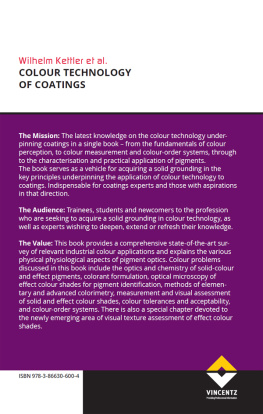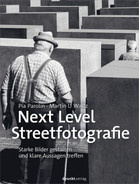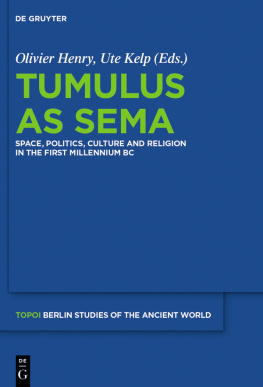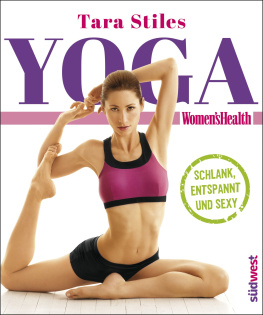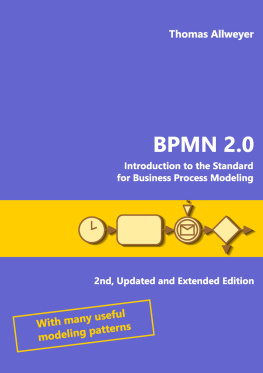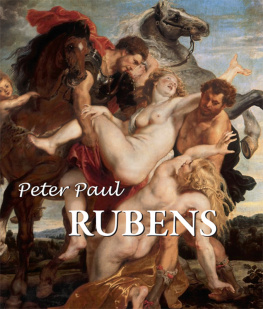Walter Franz | Peter Gabel | Stephan Gauss | Uwe Hempelmann | Rainer Henning | Wilhelm Kettler | Hans-Jrg Kremitzl | Gerhard Rsler/translated by Manfred Binder | Sandra Weixel | Gerhard Wilker
Bibliographische Information der Deutschen Bibliothek
Die Deutsche Bibliothek verzeichnet diese Publikation in der Deutschen Nationalbibliographie; detaillierte bibliographische Daten sind im Internet ber http://dnb.ddb.de abrufbar.
Wilhelm Kettler et al.
Colour Technology of Coatings
Hanover: Vincentz Network, 2016
EUROPEAN COATINGS library
ISBN 3-86630-600-8
ISBN 978-3-86630-600-4
2016 Vincentz Network GmbH & Co. KG, Hanover
Vincentz Network, Plathnerstr. 4c, 30175 Hanover, Germany
This work is copyrighted, including the individual contributions and figures.
Any usage outside the strict limits of copyright law without the consent of the publisher is prohibited and punishable by law. This especially pertains to reproduction, translation, microfilming and the storage and processing in electronic systems.
Please ask for our book catalogue
Vincentz Network, Plathnerstr. 4c, 30175 Hanover, Germany
T +49 511 9910-033, F +49 511 9910-029
Satz: Danielsen Mediendesign, Hanover, Germany
ISBN 3-86630-600-8
ISBN 978-3-86630-600-4
eBook-Production:
readbox publishing, Dortmund, Germany
www.readbox.net
Preface
Like many other textbooks, this one has its origins in the classroom and is the culmination of more than 10 years experience of teaching courses on colorimetry to engineers and technicians from various branches of industry.
The VDMI, the VdL and the FPL asked various experts at pigments, paints, and instrument makers in 2000 to design various training modules for colourists working on industrial, plastics, paint, and print applications of colour.
The objective was to provide a technically correct and up-to-date introduction to those many aspects of colour and colour applications in industry. The target group was engineers deeply involved in colour applications in various industrial sectors. The first set of training modules was offered in 2001. Until retiring in 2014, Dr. Tasso Burle successfully steered the ship for almost 14 years, taking charge of the training modules. He continually refined and modified the underlying concept to meet the demands of the participants and participating industries and also acted as publisher of the German edition of this book. The latest version comprises just two modules covering elementary concepts of colorimetry and in-depth insights in colorimetry. Although the main focus is on paint applications, all the methods presented can be readily adapted to colour applications in other industries.
The main purpose of this book is to provide a comprehensive survey of relevant industrial colour applications and numerous concepts of physical and physiological pigment optics in order that a written record may be preserved of the specialist knowledge of all the lecturers involved in the coloristic training course. The colour problems discussed in this book include optics and chemistry of solid-colour and effect pigments, colourant formulation, optical microscopy of effect colour shades for pigment identification, methods of elementary and advanced colorimetry, measurement and visual assessment of solid and effect colour shades, colour tolerances and acceptability, and colour-order systems. Compared to the first German edition, this English edition contains a further chapter devoted to the newly emerging area of visual texture assessment of effect colour shades. Although technology for measuring visible texture is already available on the market, no mathematically rigorous definition of texture parameters and their dimensionality has been formulated so far that would be accepted throughout the colour community. However, a combination of multidimensional texture and colour information is the appropriate paradigm to adopt for proper physical characterisation of the visual appearance of effect colour shades. The contents of this book are a mix of objective detachment on one hand and a detailed first-hand knowledge and practical relevance on the other.
The mathematics throughout the book have been kept to a minimum, even though the technical treatment of colour problems is being driven more and more by mathematical models. Many references at the ends of chapters cite original papers. The reader is encouraged to consult these as further sources of information and to supplement the physical and physiological basics presented in this book with more general mathematics and rigor, as necessary.
As this English edition of the training course for colourists was being prepared, one of the authors, Dr. Gerhard Rsler, unexpectedly passed away in December 2012. I believe that Gerhard would be pleased with the expanded English edition of our joint project.
Wilhelm H. Kettler
Wlfrath, Germany, January 2016
Contents
Stefan Gauss
Gerhard Rsler, translated by Manfred Binder
Gerhard Rsler, translated by Manfred Binder
Peter Gabel
Gerhard Rsler, translated by Manfred Binder
Gerhard Rsler, translated by Manfred Binder
Gerhard Rsler, translated by Manfred Binder
Gerhard Rsler, translated by Manfred Binder
Stefan Gauss
Gerhard Rsler, translated by Manfred Binder
Gerhard Rsler, translated by Manfred Binder
Gerhard Rsler, translated by Manfred Binder
Wilhelm Kettler
Wilhelm Kettler
Wilhelm Kettler
Uwe Hempelmann
Uwe Hempelmann
Sandra Weixel
Rainer Henning
Rainer Henning
Hans-Jrg Kremitzl
Peter Gabel and Gerhard Pfaff
Uwe Hempelmann
Gerhard Wilker
Get your exclusive information add-on!
In addition to this books contents, EUROPEAN COATINGS library has compiled an exclusive selection of bonus materials for you. Just visit www.european-coatings.com/bonus and get free access to your personal bonus materials!
Book code: LA2019B
I Fundamentals of colour perception
Stephan Gauss
Human colour vision
The term colour has different meanings. It is used variously to describe a characteristic of an object perceived by the eye, a paint or surface coating applied to a garden fence, and it can refer to a printing ink. Consider also the various materials, which give these products their colour. Such colourants are either pigments (insoluble in the paint or coating medium), or dyes (soluble in the medium), see Chapter IX. Colourants can be further ordered according to their colour index (C.I.), which more accurately should be called colourant index.
A question that often arises during daily work in the paint and coatings industry is: is todays production batch the same colour as the reference sample? This book will show how we can obtain useful numbers from this perception in the brain to help us answer that question.
Any description of the term colour must distinguish between the physical processes that lead to a sensory stimulus in our eyes and our own subjective evaluation of that stimulus, which is transmitted from the eye to the brain. This is shown in .
The left column in .
It is important to understand that the colour of an object exists only in our mind; different people may describe the colour of the same object differently. For this reason, it is common practice in the commercial world to talk instead about the colour differences from a given reference standard and not about the colour itself. Naturally, the coloristic attributes of the reference standard must be close to those of the sample being assessed. Because colour differences are usually small, people usually find it easier to agree on them. These colours are also known as related colours.

